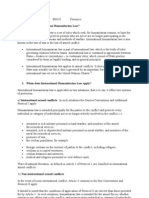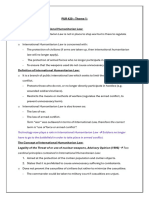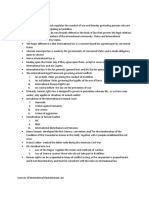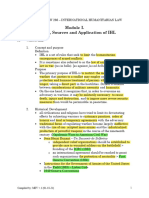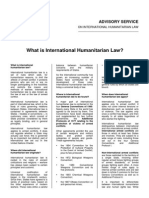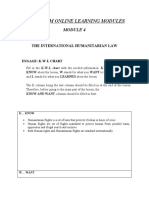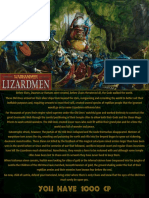0 ratings0% found this document useful (0 votes)
1 viewsPUR 420 - Lecture 2
PUR 420 - Lecture 2
Uploaded by
kalmkraftersInternational Humanitarian Law
Copyright:
© All Rights Reserved
Available Formats
Download as PDF, TXT or read online from Scribd
PUR 420 - Lecture 2
PUR 420 - Lecture 2
Uploaded by
kalmkrafters0 ratings0% found this document useful (0 votes)
1 views5 pagesInternational Humanitarian Law
Copyright
© © All Rights Reserved
Available Formats
PDF, TXT or read online from Scribd
Share this document
Did you find this document useful?
Is this content inappropriate?
International Humanitarian Law
Copyright:
© All Rights Reserved
Available Formats
Download as PDF, TXT or read online from Scribd
Download as pdf or txt
0 ratings0% found this document useful (0 votes)
1 views5 pagesPUR 420 - Lecture 2
PUR 420 - Lecture 2
Uploaded by
kalmkraftersInternational Humanitarian Law
Copyright:
© All Rights Reserved
Available Formats
Download as PDF, TXT or read online from Scribd
Download as pdf or txt
You are on page 1of 5
PUR 420 – Lecture 2:
Sources of International Humanitarian Law:
o Article 38(1) (a) – (d) of the Statute of the International Court of justice:
(a) International conventions, whether general or particular, establishing rules
expressly recognised by the contesting states.
(b) International customs, as evidence of a general practice accepted as law.
(c) The general principles of law recognised by civilized nations.
(d) Judicial decisions and the teachings of the most highly qualified publicist’s pf the
various nations, as subsidiary mean for the determination of rules of law.
o Main sources of International Humanitarian Law.
- Treaties.
- Customary International Humanitarian Law.
Categorisation of Treaties:
o Subject matter.
- Protection of civilians and combatants.
o Methods and means of warfare.
- How do states acts when in an armed conflict and what time of weapons should
be used.
o Regulate naval and air warfare.
o Protection of cultural property.
- Certain places that cannot be bombed.
e.g. Universities and Museums etc.
o Regulate criminal repression of war times.
- Regulate the criminal aspects of the war.
e.g. Rome Statues → Crimes against humanity.
o Regulate international and not international conflicts.
Subject Matter Treaties:
o Geneva Conventions, 1949 – Protection of victims of armed conflicts:
1. To ameliorate the condition of the wounded and sick in armed forces in the
field.
2. To ameliorate the condition of the wounded, sick and shipwrecked member
of armed forces at sea.
3. To regulate the treatments of prisoners of war.
4. To protect civilians in time of war.
o Geneva Conventions are supplemented by Additional Protocols of 1977:
- Protocol 1 → The protection of victims of international armed conflicts.
(Interlinked with protection of cultural property and repression of war crimes).
- Protocol 2 → Protection of victims of non-intentional armed conflicts.
- Protocol 3 → ICRC deals with the types of embalms that can be used and are
recognised.
Methods and means of warfare Treaties:
o The Fourth Convention of 1907 – Respecting the Laws and Customs of War on Land
and its annexed regulations – Hague Conventions.
- The status of belligerents.
- The conduct of hostilities,
- The prohibitions of weapons ‘calculated to cause unnecessary suffering’.
- The termination of hostilities and rules governing military occupations.
o Certain Conventional Weapons Conventions, 1980:
- The purpose is to ban or restrict the use of specific types of weapons that are
considered to cause unnecessary or unjustifiable suffering to combatants or to
affect civilians indiscriminately.
o Supported by additional protocols:
- Protocol 1: Non – Detectable Fragments, 1980.
- Protocol 2: Mines, Booby Traps and Other Devices, 1996 (Amended).
- Protocol 3: Incendiary Weapons, 1980.
- Protocol 4: Blinding Laser Weapons, 1995.
- Protocol 5: Explosive Remnants of War, 2003.
Naval and Air Warfare’s Treaties:
o Hague Convention (X) for the Adaptation to Maritime Warfare and the Principles of
the Geneva Convention,1907.
o Protection of cultural property treaties:
- Hague Convention for the Protection of Cultural Property in the Event of Armed
Conflict, 1954.
o Criminal repression of war crimes treaties:
- Rome Statue of the International Criminal Court, 1998.
International Armed Conflicts and Non-International Armed Conflicts:
o The International Humanitarian Law rules make a distinction between international
armed conflicts (IAC) and non-international armed conflicts (NIAC).
International Armed Conflicts:
▪ Tadic paragraph 70 - ‘An armed conflict exists whenever there is a resort to
armed force between States’.
- Article 2(1) of the Geneva Convention 1 – 4: International
Humanitarian Law applies ‘to all cases of declared war or of any other
armed conflict which may arise between two or more of the High
Contacting Parties, even if the state of war is not recognised by one of
them.
▪ Article 1(4) of Additional Protocol 1 – An international armed conflict is
extended to ‘armed conflicts in which peoples are fighting against colonial
domination, alien occupation and against racist regimes in the exercise of
self-determination.’
▪ National Liberation Movement required to deposit a declaration accepting
the obligations under the law of Geneva with the Swiss Federal Council; in
order to be protected under International Humanitarian Law.
Non – International Armed Conflicts:
▪ Tadic paragraph 70 – ‘An armed conflict exists whenever there is a protected
armed violence between governmental authorities and organised armed
groups or between such groups within a State’.
- Only Article 3, common to all Geneva Conventions and Additional
Protocol 2 apply to Non-International Armed Conflicts.
- Additional Protocol 2 develops and supplements common article 3 of
the Geneva Conventions Article 1(1).
▪ Common Article 3 – Each party to the non-international armed conflict is
bound to accept, ‘as a minimum’, that persons taking no active part in
hostilities are to be treated humanely, without any adverse distinction based
on race, colour, religion or faith, sex, birth, or wealth.
▪ The wounded and the sick are also to be cared for.
▪ Parties to a non-international armed conflict are not entitled to the privilege
accorded to combatants in international-armed conflicts – however have no
right to be treated as prisoners of war.
o Additional Protocol 2 contains more detailed provisions on fundamental
guarantees, treatment of the wounded and sick and protection of the civilian
populations.
- However, it is more restricted than Common Article 3.
o Additional Protocol 2 applied only to armed conflicts which takes place in a party to
Additional Protocol 2 between its armed forces and dissident armed forces which,
under responsible command, ‘exercise such control over a part of its territory as to
enable them to carry out sustained and concerted military operations and to
implement this protocol.
Applicability of Law of Treaties:
o Vienna Convention on the Law of Treaties, 1969 applies to:
- Treaty-making - Negotiations, conferences.
- Reservations.
- Successive treaties:
▪ International Humanitarian Law treaties contain specific provisions
which explain the relation to earlier treaties.
- Interpretation.
- Many International Humanitarian Law treaties contain provisions that explain
relations between states parties and third states.
- Termination of treaties.
Customary International Humanitarian Law:
o Two requirements of Custom:
- State practice (usus).
- Belief to be bound by rule (opinio juris).
o International Committee of the Red Cross mandared by the 26th Conference of
the Red Cross and Red Crescent, 1995, to engage in the study of customary
international humanitarian law.
- Look at 2 requitements to govern what the rules of customary international
humanitarian law.
Does not come up with the customary laws/rules they just combine the laws
and rules into one place → Under one umbrella definition.
o International Committee of the Red Cross → 161 Customary International
Humanitarian Law rules.
You might also like
- The Black Sun and Vril SocietyDocument10 pagesThe Black Sun and Vril SocietyStefan Bogdan Pavel100% (1)
- XIII. International Humanitarian LawDocument18 pagesXIII. International Humanitarian LawRicardo Enriquez JrNo ratings yet
- Law of Armed Conflict OutlineDocument12 pagesLaw of Armed Conflict OutlineEthan MatchettNo ratings yet
- Basic Rules of The Geneva Conventions and Their Additional ProtocolsDocument32 pagesBasic Rules of The Geneva Conventions and Their Additional ProtocolsInternational Committee of the Red Cross100% (1)
- FM 57-23 (1989) ADVANCED PARACHUTING TECHNIQUES AND TRAININGDocument320 pagesFM 57-23 (1989) ADVANCED PARACHUTING TECHNIQUES AND TRAININGalexNo ratings yet
- International Humanitarian LawDocument30 pagesInternational Humanitarian LawDaphne Angela Logarta Ortezuela100% (2)
- International Humanitarian LawDocument3 pagesInternational Humanitarian Lawjelly daleNo ratings yet
- 2021 Law of Armed ConflictDocument47 pages2021 Law of Armed ConflictGloriaNo ratings yet
- PUR 420 - Lecture 1Document7 pagesPUR 420 - Lecture 1kalmkraftersNo ratings yet
- IHL PrinciplesDocument41 pagesIHL PrinciplesD Del Sal0% (1)
- History and ClassificationDocument6 pagesHistory and Classificationdinesh rokkaNo ratings yet
- Ihl Exam NotesDocument40 pagesIhl Exam NotesSarthak JainNo ratings yet
- IHL Class 1 - Intro (1)Document27 pagesIHL Class 1 - Intro (1)barnabasetyang1No ratings yet
- Ihl (2007)Document75 pagesIhl (2007)geronsky06No ratings yet
- IHL Class 2 - Classification (1)Document11 pagesIHL Class 2 - Classification (1)barnabasetyang1No ratings yet
- Introduction To Ihl 1Document37 pagesIntroduction To Ihl 1TrexPutiNo ratings yet
- Laws On Armed Conflict: Saint Louis University School of LawDocument11 pagesLaws On Armed Conflict: Saint Louis University School of LawRampage Dx100% (1)
- Ihl 2Document11 pagesIhl 2ZerayohannesNo ratings yet
- IHLDocument43 pagesIHLVijay JhingaNo ratings yet
- International Humanitarian LawDocument14 pagesInternational Humanitarian Lawleslieca1511No ratings yet
- PIL REVIEW J&KDocument15 pagesPIL REVIEW J&KjacquelynvelardeNo ratings yet
- Public International Law - NotesDocument8 pagesPublic International Law - NotesChaudhry Ahmed XNo ratings yet
- The Geneva ConventionDocument6 pagesThe Geneva ConventionAnupam GurungNo ratings yet
- Ihl Int 14-1Document30 pagesIhl Int 14-1jahrastafarilionofjudahinzionNo ratings yet
- 5.1 The Basics of International Humanitarian LawDocument7 pages5.1 The Basics of International Humanitarian LawRishi Agarwal100% (1)
- 2012 Lecture 1 Intro To Ihl and Qualification - HandoutDocument40 pages2012 Lecture 1 Intro To Ihl and Qualification - Handoutmustebedaso123lawyerNo ratings yet
- IHL-PPT latest-1Document95 pagesIHL-PPT latest-1Muluken AmareNo ratings yet
- Human Rights ProjectDocument20 pagesHuman Rights ProjectAditiNo ratings yet
- International Humanitarian LawDocument17 pagesInternational Humanitarian Lawmd.kamrul hasan riadNo ratings yet
- Topic 4 International (IAC) & Non-International Armed Conflict (NIAC)Document35 pagesTopic 4 International (IAC) & Non-International Armed Conflict (NIAC)riasat.azim9No ratings yet
- SIxtine Schaffers - LOAC - 2022-2023Document75 pagesSIxtine Schaffers - LOAC - 2022-2023Chris GreenSoulNo ratings yet
- Fundamental Principles of International Humanitarian Law: University of Sto. TomasDocument14 pagesFundamental Principles of International Humanitarian Law: University of Sto. TomasRimvan Le SufeorNo ratings yet
- Ihl & Source of IhlDocument5 pagesIhl & Source of Ihlmohd saadNo ratings yet
- Genava Conventions of 1949Document3 pagesGenava Conventions of 1949Marc VeldtNo ratings yet
- PIL Chapter14Document36 pagesPIL Chapter14Juris PoetNo ratings yet
- Unwritten Rules Based On CustomDocument29 pagesUnwritten Rules Based On CustomShieremell DiazNo ratings yet
- Notes On IHLDocument7 pagesNotes On IHLFrankel Gerard MargalloNo ratings yet
- LLB Hons. PU Week 3 War, Armed Conflicts and Other HostilitiesDocument46 pagesLLB Hons. PU Week 3 War, Armed Conflicts and Other HostilitiesJannah SaeedNo ratings yet
- HR LAW - Lecture 10Document14 pagesHR LAW - Lecture 10Saqlain HyderNo ratings yet
- Ihl 2Document59 pagesIhl 2Sarthak JainNo ratings yet
- Opinion Paper Armed ConflictDocument5 pagesOpinion Paper Armed Conflictazuka_devil6667485No ratings yet
- International Armed ConflictDocument8 pagesInternational Armed ConflictHamna JavedNo ratings yet
- Additional Protocols To The Geneva Conventions of 1949Document2 pagesAdditional Protocols To The Geneva Conventions of 1949chitru_chichruNo ratings yet
- Villanueva IHL NotesDocument88 pagesVillanueva IHL NotesMohammad Al-Gandhi CampongNo ratings yet
- International Humanitarian LawDocument3 pagesInternational Humanitarian LawAnonymous lYiFLvV10% (1)
- International Humanitarian Law Lecture 1Document21 pagesInternational Humanitarian Law Lecture 1pradhyumn yadavNo ratings yet
- Fundamental Principles of International Humanitarian LawDocument38 pagesFundamental Principles of International Humanitarian LawNene onetwoNo ratings yet
- Lecture 3. IHL 07slidesDocument29 pagesLecture 3. IHL 07slidesKrisha Marijoule SuasinNo ratings yet
- What Is International Humanitarian LawDocument11 pagesWhat Is International Humanitarian LawVolodymyr DidkivskyiNo ratings yet
- Origin and Sources of IHLDocument11 pagesOrigin and Sources of IHLJoker PrankNo ratings yet
- IL International Humanitarian LawDocument13 pagesIL International Humanitarian LawSycelle Lou Patrick100% (1)
- The Main Sources of International Humanitarian Law: Treaty Law Customary LawDocument2 pagesThe Main Sources of International Humanitarian Law: Treaty Law Customary LawRicha KesarwaniNo ratings yet
- Humantarian and Refugee LawDocument59 pagesHumantarian and Refugee LawShahnoor Ali 7452 KCLF 18No ratings yet
- What Is International Humanitarian LawDocument11 pagesWhat Is International Humanitarian LawVolodymyr DidkivskyiNo ratings yet
- Introduction To International Humanitarian LawDocument19 pagesIntroduction To International Humanitarian Lawgautamnishi05No ratings yet
- What Is International Humanitarian Law?: Advisory ServiceDocument2 pagesWhat Is International Humanitarian Law?: Advisory ServiceJamil B. AsumNo ratings yet
- IHL NotesDocument12 pagesIHL NotesRomaisa khan SultanNo ratings yet
- Final Term Online Learning ModulesDocument49 pagesFinal Term Online Learning ModulesKenneth AbatonNo ratings yet
- The Geneva Conventions of 1949 and Their Additional ProtocolsDocument3 pagesThe Geneva Conventions of 1949 and Their Additional ProtocolsLeslie LernerNo ratings yet
- IHL Applicable To Non-International Armed ConflictsDocument10 pagesIHL Applicable To Non-International Armed ConflictsAnonymous 96YEqf9oNo ratings yet
- War Crime: Unveiling the Shadows, The Hidden Ethics of Modern WarfareFrom EverandWar Crime: Unveiling the Shadows, The Hidden Ethics of Modern WarfareNo ratings yet
- Geneva Conventions: Rules of Warfare and Humanitarian PrinciplesFrom EverandGeneva Conventions: Rules of Warfare and Humanitarian PrinciplesNo ratings yet
- Fire Knives in SaltmarshDocument2 pagesFire Knives in SaltmarshBen JuciusNo ratings yet
- Coast Artillery Journal - Mar 1930Document96 pagesCoast Artillery Journal - Mar 1930CAP History LibraryNo ratings yet
- Red Sun Travels in Naxalite Country by Sudeep Chakravarti PDFDocument218 pagesRed Sun Travels in Naxalite Country by Sudeep Chakravarti PDFBasu VNo ratings yet
- Antigone 44 4Document2 pagesAntigone 44 4Slovenian Webclassroom Topic ResourcesNo ratings yet
- The Pittston Dispatch 02-17-2013Document62 pagesThe Pittston Dispatch 02-17-2013The Times LeaderNo ratings yet
- Comparison of Book Iliad and The Film TroyDocument3 pagesComparison of Book Iliad and The Film Troydawn14100% (4)
- Emergency Planning Guide ShoolsDocument211 pagesEmergency Planning Guide ShoolsArianna IsabelleNo ratings yet
- Mass Effect - TimelineDocument2 pagesMass Effect - TimelineIvan Tomašević100% (1)
- Principles. Deception.: Area DefenceDocument1 pagePrinciples. Deception.: Area DefenceGrozny GroznyNo ratings yet
- HITLER'S JEWISH ARMY German ArmyDocument19 pagesHITLER'S JEWISH ARMY German ArmyEcaterinaDochian100% (5)
- Warhammer Fantasy - Lizardmen JumpChainDocument11 pagesWarhammer Fantasy - Lizardmen JumpChainketch117No ratings yet
- MP5 IpbDocument14 pagesMP5 IpbJulieth MahechaNo ratings yet
- Dostoevsky's Nationalism Author(s) : Hans Kohn Source: Journal of The History of Ideas, Oct., 1945, Vol. 6, No. 4 (Oct., 1945), Pp. 385-414 Published By: University of Pennsylvania PressDocument31 pagesDostoevsky's Nationalism Author(s) : Hans Kohn Source: Journal of The History of Ideas, Oct., 1945, Vol. 6, No. 4 (Oct., 1945), Pp. 385-414 Published By: University of Pennsylvania PressNiharika RanjanNo ratings yet
- RRP 2021 Modern History Ready ReckonerDocument99 pagesRRP 2021 Modern History Ready Reckonerhaha kumarNo ratings yet
- 21st PalestinianLiteratureDocument35 pages21st PalestinianLiteratureYuka RebambaNo ratings yet
- Philippine Claims To IslandsDocument52 pagesPhilippine Claims To IslandsRichard BalaisNo ratings yet
- 2024-2025 Ogden School District CalendarDocument1 page2024-2025 Ogden School District Calendarhansensuz0% (1)
- Red Mage1Document6 pagesRed Mage1Simone0% (1)
- Civilsdaily - Essay Introductions by RankersDocument18 pagesCivilsdaily - Essay Introductions by Rankersus.dtu22No ratings yet
- Minusma Daily Flights Schedule / Air Tasking Order MONDAY, 24 APRIL 2023 Aviation SectionDocument12 pagesMinusma Daily Flights Schedule / Air Tasking Order MONDAY, 24 APRIL 2023 Aviation SectionДенис ЮхненкоNo ratings yet
- The Market For Air-to-Air Missiles: Product Code #F659Document16 pagesThe Market For Air-to-Air Missiles: Product Code #F659spacenavy90No ratings yet
- 04 Greek ArchitectureDocument7 pages04 Greek ArchitecturePaolo OcampoNo ratings yet
- Toxic Leadership PDFDocument5 pagesToxic Leadership PDFPeter TranNo ratings yet
- GorechosenDocument24 pagesGorechosenvincent100% (3)
- Pub160 2013 PDFDocument391 pagesPub160 2013 PDFbubu_18No ratings yet
- Historical Development of Physical EducaDocument37 pagesHistorical Development of Physical EducaMark Johnson San JuanNo ratings yet
- CavernCrawl 2.0Document26 pagesCavernCrawl 2.0Chris T.No ratings yet
- Letter Back HomeDocument2 pagesLetter Back HomenihaalcNo ratings yet





